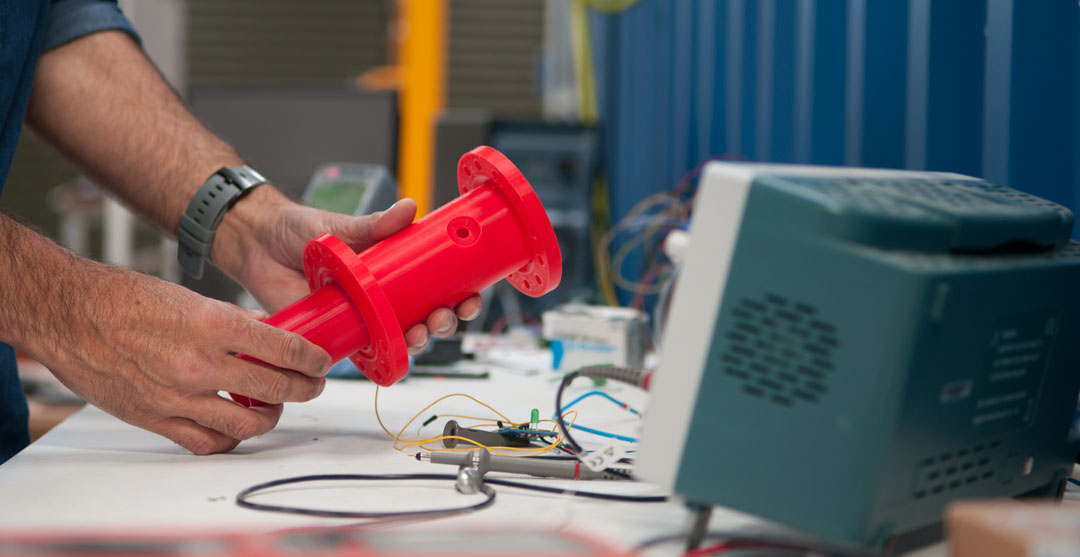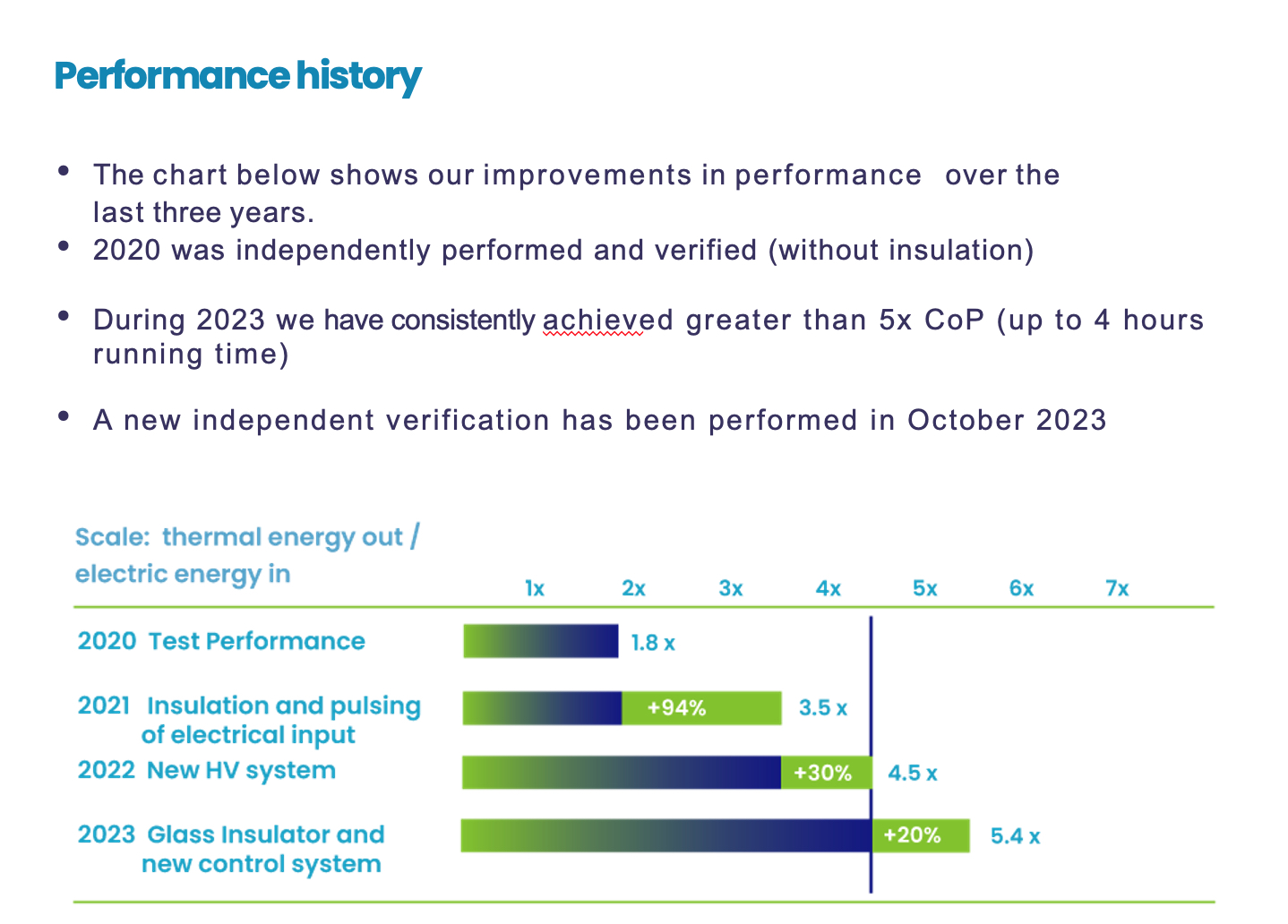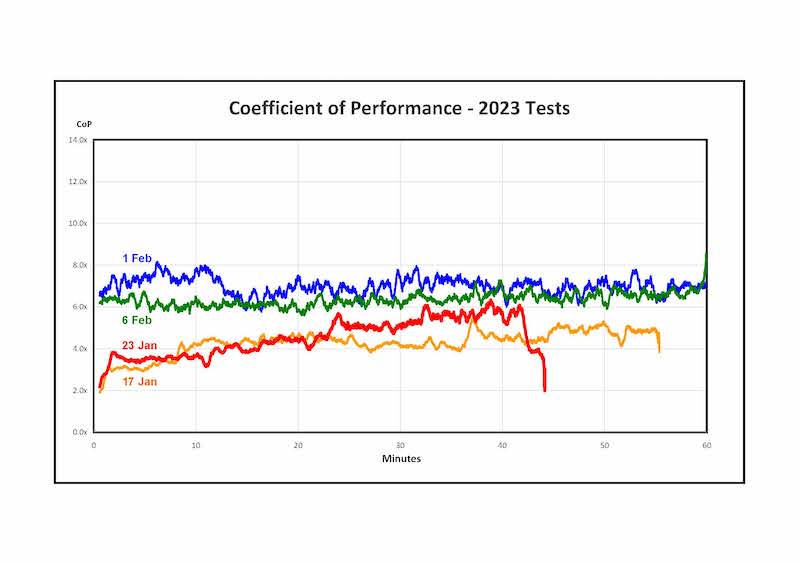Your questions our answers
FAQ


We are on a journey to make a difference in the Energy sector.
As our technology develops there will be undoubtably questions to the, how, what and when. We have collected a series of questions that have been asked on numerous occasions below.

Approach
01
Innovation
This graph shows how we have continued to increase performance of the Energy Cell from below 2 at the time of our independent verification to consistently above 5 in 2023.
This graph shows how we have continued to increase performance of the Energy Cell from below 2 at the time of our independent verification to consistently above 5 in 2023.
- Some of the key steps have been:-
- Understanding the importance of the parameters creating a new electrode design.
- Redesigning and installing a more efficient high voltage system.

02
Inputs / Outputs
This graph shows the consistency of the performance across a series of tests in January and February.
This culminated in five separate witnessed trial runs on 31st Jan / 1st Feb and 6th Feb
This culminated in five separate witnessed trial runs on 31st Jan / 1st Feb and 6th Feb

03
Results
The chart shows the specific inputs and outputs of one of our trial and demonstrations on 1st Feb.The results are consistently above a Coefficient of Performance of 7.Other key features - 14 g / sec of water produced 50 kW - th output.Pressure was held at 20 bar.
Frequently asked questions
What does a Coefficient of Performance mean?
The Coefficient of Performance (COP) is a measure of how efficiently a heating or cooling system, like a heat pump, uses energy. It's the ratio of the useful heating or cooling output to the energy input (like electricity). A higher COP indicates better efficiency, meaning the system provides more heating or cooling for the same amount of energy input.
Table of Coefficient of Performance
(tbi)
Biaco’s coefficient of performance has been verified and is the subject to a peer reviewed scientific publication (Quarter 3 2025).
How does this work – surely you are breaking the second law of thermodynamics?
Biaco’s technology works by utilising the adjuncts (metals, minerals, gases etc) held in water sourced from municipal supply or from grey water. The Biaco system creates a plasma in water. The temperatures reached under the specific conditions created are very high. In micro seconds, exothermic reactions occur which utilize the adjuncts in the aqueous carrier (normally water) and create many different and complex interactions of elements. These generate heat in the form of light. The light heats the vessel and the water in it turning the water into high grade superheated steam. Water used by the system can be recycled for normal household usage.
The specific chemical reactions are subject to further academic verification before publishing, but we can state that the process includes CO2 sequestration.
Output
The cell’s capacity is between 20 to 35kW-th which is reached at an input energy level of 5 to 9kW-e. Our first system will utilise 2 cells to give a 50kW-th output rating.Our scientific programme in 2025 will include more work on spectroscopy, differential aqueous mixes – contaminated water, brine, sewage, etc – and further work on the electrical requirements of the system.
The specific chemical reactions are subject to further academic verification before publishing, but we can state that the process includes CO2 sequestration.
Output
The cell’s capacity is between 20 to 35kW-th which is reached at an input energy level of 5 to 9kW-e. Our first system will utilise 2 cells to give a 50kW-th output rating.Our scientific programme in 2025 will include more work on spectroscopy, differential aqueous mixes – contaminated water, brine, sewage, etc – and further work on the electrical requirements of the system.
When will it be commercialised?
Currently at technology readiness level (TRL) 6, we are trialing in house (TRL 7) and then will move to external trials at the end of the year.
We are working towards having a commercial prototype with customers for trial by 2026. An initial trial of the commercial prototype will be under strict control with long term partners and clients. The initial product will be a space heater able to give an output of 50 kW.
We are working towards having a commercial prototype with customers for trial by 2026. An initial trial of the commercial prototype will be under strict control with long term partners and clients. The initial product will be a space heater able to give an output of 50 kW.
How much will it cost to install and run?
The initial industrial products will be priced at circa £1000 per kW of output, with running costs up to 30% lower than current natural gas systems. The running costs will depend on the daily rate of electricity charged.
What can it be used for?
Heat and cold
The exergy of the heat (high temperature and pressure) means that the heat can be produced as cold from -34℃ to high grade heat up to 230℃. Higher temperatures can be reached at higher pressures for certain industries.
Waste removal and cleaning
The system removes the adjuncts (gases and minerals) held in an aqueoussolution and consumes them during an exothermic reaction creating clean waterand energy. Each unit cleans about 40 litres of water an hour.
The exergy of the heat (high temperature and pressure) means that the heat can be produced as cold from -34℃ to high grade heat up to 230℃. Higher temperatures can be reached at higher pressures for certain industries.
Waste removal and cleaning
The system removes the adjuncts (gases and minerals) held in an aqueoussolution and consumes them during an exothermic reaction creating clean waterand energy. Each unit cleans about 40 litres of water an hour.
How have you protected the IP?
Yes. This is an ongoing process as we continue to develop this technology. We will continue to monitor and identify any new innovations relating to this technology, with new patent applications being filed accordingly for such innovations. There are seven different patent families on file, with at least 45 different identified inventions detailed among those seven families. The patent portfolio will continue to grow. We are continuing to receive positive feedback in relation to the pending applications in the portfolio, and at present there are three granted UK patents, with more grants expected in the coming months.
How much money will you make on each unit?
We are targeting a realistic margin on each unit in order to fund the ongoing investment in this new and growing clean technology. The intention is for product prices to be rapidly recouped by the savings made by the client.
Who owns the company?
The company is owned by the founders and investors who number over 180 in total. The Directors (including non-executive members) control over 50% of the equity.
Why is it better than a Heat Pump?
The advantages over a heat pump are:-
→ Cost – expected deliverable cost is 50% of a heat pump
→ Output – can deliver 50kW of high grade heat – a single heat pump can deliver 12 kW
→ Operating cost is lower than a heat pump (60%of running cost)
→ Size – the cell is small and modular – suitable for retrofitting into an existing heating system.
→ Seasonality – a heat pump works better in the warmer seasons not during periods of low temperatures when heat is needed. A Biaco system is seasonally agnostic.
→ Carbon – the Biaco system sequestrates carbon during operation (1g per kW of heat produced).
→ Cost – expected deliverable cost is 50% of a heat pump
→ Output – can deliver 50kW of high grade heat – a single heat pump can deliver 12 kW
→ Operating cost is lower than a heat pump (60%of running cost)
→ Size – the cell is small and modular – suitable for retrofitting into an existing heating system.
→ Seasonality – a heat pump works better in the warmer seasons not during periods of low temperatures when heat is needed. A Biaco system is seasonally agnostic.
→ Carbon – the Biaco system sequestrates carbon during operation (1g per kW of heat produced).
Can it really replace Gas?
Replacing the entire UK Gas network 687 TWhrs of gas in 2024 (70% of UK energy) is a huge task.
30 million homes.
1.4 million offices and businesses with employees.
To do that will require resources and time!
30 million homes.
1.4 million offices and businesses with employees.
To do that will require resources and time!
How will you get the resources to do this?
So far we have limited our equity search to interested parties such as family, friends and introduced high net worth individuals. These generous people have been instrumental in getting us to the stage where the technology is published and patented.
We are now widening our reach to the larger sovereign funds and “green” investment funds to raise the money for expansion, investment into the people we need and to allow us to build working capital and critical financial resilience through the lab to commercial period.
We are now widening our reach to the larger sovereign funds and “green” investment funds to raise the money for expansion, investment into the people we need and to allow us to build working capital and critical financial resilience through the lab to commercial period.
Why haven’t I read about it in the press?
Biaco has intentionally kept out of social media apart from brief bursts of news around collaborations and verification. This is to protect the technology through the IP and publication stage. During 2025 we will build our external PR presence starting with the verification publication in Advanced Thermal Engineering.